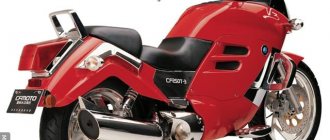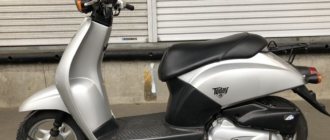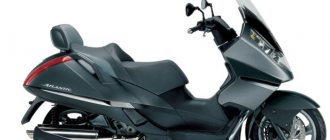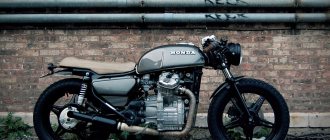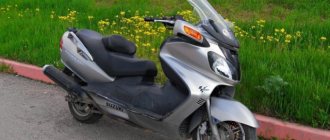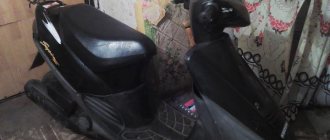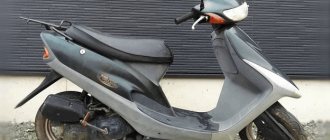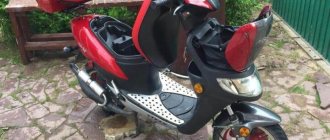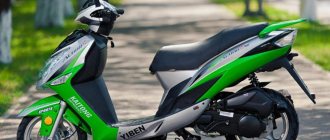001_MOTO_1210_034
BMW C1–200: maxiscooter, 2002, 199 cm³, 17 hp, 184 kg, 100–200 thousand rubles.
BMW C1–200: maxiscooter, 2002, 199 cm³, 17 hp, 184 kg, 100–200 thousand rubles.
This scooter with a roof itself already provides a very high level of comfort: there is not only weather protection, but also a windshield wiper, heated handles and seats, full ABS and many other bells and whistles. But the Velorex stroller, which was “made friends” with the scooter both in terms of fastenings and color, helped to radically solve the issue of stability on slippery surfaces. We couldn’t do without Schwalbe Scooter winter tires, which the inhabitants of the Alps cheerfully ride on (more about it in “Moto” No. 02–2006). But Velcro is almost powerless on ice - I had to stud it. Naturally, the standard BMW 12-inch wheel with winter tires was also installed on the stroller. Along the way, there was a decent audio system with component acoustics and a subwoofer, which also serves as ballast for the stroller. The set of functional tuning was completed with an on-board thermometer, “mittens” on the steering wheel, a windproof cover on the legs and – the main feature of any real pepelats – a rotating anemometer on the roof.
The first trips were to the bike rallies “Lev Nikolaevich” near Tula in the fall and “Bear-Shatun” in December. But the real test was going to Snow Dogs in Tolyatti. A thousand kilometers one way at minus 10–28 °C, meeting the “Bear Mile” standard along the way there and back. By summer standards, this is immodest for a moped, let alone in winter! However, the three-wheeled C1 very confidently rushes along the by no means easy winter federal highway. At speeds of 100–110 km/h, he confidently overtakes trucks in the uncleared middle of the road, he doesn’t sway too much in the ruts, the oncoming flow of frosty air breaks against the wide glass, the hands warm, the music sings. Easy to control, stable and predictable even in the snow - isn’t this ideal? You don’t get tired of the road at all - the main thing is to properly insulate yourself, taking into account the fact that it is impossible to move or warm up in the saddle. Although the distances between gas stations are short (120–150 km), at a cruising speed of 80–90 km/h, each of them is two hours of almost static sitting in the cold. In addition, given the short daylight hours, with long runs, a considerable part of the journey has to be covered in the dark. Then it becomes clear that a dead standard scooter headlight, equipped with a single 35/30W bulb, requires urgent tuning. Nevertheless, winter long-distance driving is thrilling in its own way, at other moments even more interesting than summer - it’s worth remembering the open mouths of gas station attendants, drivers and other eyewitnesses.
Last year's trip to Snow Dogs in the Ural with a stroller took 22 hours there and 17 back in much warmer weather. Compared to the C1, the Ural simply does not have wind protection, which is why the cruising speed is lower, and the driver gets colder, there is no heating, and the dynamics of the devices are similar. But, unlike a German moped, it breaks down much more often on the road, which causes special emotions in winter, when your fingers freeze to the screwdrivers.
Yes, the C1 series of scooters, as they say, “didn’t work” in the markets, but it’s unlikely that any of the developers considered this smallest of the BMW motorcycle family for winter riding. And as it turned out, it is ideal for this: those who don’t like cats simply don’t know how to cook them.
Start
In 1913, two small aircraft engine companies appeared on the outskirts of Munich. One of them belonged to Karl Rapp, and the second to Gustav Otto, the son of the inventor Nikolaus August Otto. With the outbreak of the First World War, these two companies received many orders and merged into a single aircraft engine plant, which after four years, in 1917, received the name “Baverische Motoren Werke” (Bavarian Motor Works). The plant is headed by Franz-Josef Popp. It is he who hires young Max Fritz, an aircraft engine engineer who will play a significant role in the further development of BMW. Since then, all BMW products have been produced under the familiar spinning propeller emblem.
009_MOTO_1210_034
Winter long-distance driving is thrilling in its own way, at other times even more interesting than summer - it’s worth remembering the open mouths of gas station attendants, drivers and other eyewitnesses.
Winter long-distance driving is thrilling in its own way, at other times even more interesting than summer - it’s worth remembering the open mouths of gas station attendants, drivers and other eyewitnesses.
Technical characteristics of BMW C1-200 (manufacturer data)
| COMMON DATA | |
| Model year | 2002 |
| Dry weight, kg | 184 |
| Base, mm | 1450 |
| Seat height, mm | 700 |
| Gas tank volume, l | 8 |
| ENGINE | |
| Type | 1-cyl., 4T |
| timing belt | DOHC, 4 valves per cylinder |
| Working volume, cm³ | 199 |
| Cylinder diameter x piston stroke, mm | 62x66 |
| Compression ratio | 9,2:1 |
| Max. power, hp at rpm | 17/9000 |
| Max. torque, Nm at rpm | 18/6500 |
| Supply system | Siemens fuel injection |
| Cooling system | liquid |
| Starting system | electric starter |
| TRANSMISSION | |
| Clutch | centrifugal |
| Transmission | variable speed drive |
| CHASSIS | |
| Frame | aluminum spatial |
| Front suspension | 41mm telescopic fork |
| Rear suspension | pendulum, lever-block-motor |
| Front brake | disc Ø 220mm, 2-piston Brembo caliper |
| Rear brake | disc Ø 180 mm, 1-piston Brembo caliper |
| Wheels | aluminum, cast |
| Front tire | 90/90 R13 |
| Rear tire | 90/90 R12 |
Hut on three wheels: BMW C1–200
Content
- 1 Beginning
- 2 1920s 1930s
- 3 First motorcycle
- 4 First cars
- 5 During the war
- 6 Revival
- 7 Post-war years
- 8 New rise
- 9 1973: BMW Motorcycles celebrates its anniversary
- 10 Off-road BMWs
- 11 1981: BMW R 80 G/S came, drove, conquered
- 12 1983: the birth of the K series
- 13 1987
- 14 March 18, 1991
- 15 1997-1998: new models
- 16 Model range of motorcycles:
- 17 Model range of scooters
Off-road BMW
With the revival of the motorcycle comes BMW's return to motorsport. Once again, BMW motorcycles compete with competitors away from the beaten path. In 1979, BMW wins the German Off-Road Championship. This marks the beginning of the brand's successful path in rally racing in subsequent years.
Having begun to participate in off-road racing, BMW in the summer of 1980, through some modernization, turns the successful off-road motorcycle into a serial enduro, designated R 80 G/S. The letter G stood for Gelände, that is, off-road, and the S for Straße, that is, highway. BMW thus founded the large, comfortable touring enduro segment, which is still one of the cornerstones of the motorcycle business. The world's first single-link pendulum suspension, the BMW Monolever, with a rear wheel mounted on one side, creates a sensation.
March 18, 1991
— the millionth BMW motorcycle was released. This model K 75 RT was ceremoniously handed over to the Berlin Senator for Economics and Technology to then work for the benefit of the Red Cross. In the spring of 1991, in the spring of 1991, BMW was the first motorcycle manufacturer to offer a three-way converter with exhaust gas composition control. The offer of serial machines with neutralizers is constantly expanding. 70 years after the R 32 from 1923, BMW introduced the R 1100 RS sports-touring motorcycle at the start of the 1993 season, the first model of a new generation of boxer motorcycles, and a year later the R 1100 GS enduro appeared. In the autumn of the same year, the R 850/1100 R entered the market, followed by the R 1100 RT touring motorcycle the following season. Along with the second-generation ABS, BMW is introducing its innovative front wheel steering system called Telelever with the launch of the new generation of boxer wheels.
In addition to the traditional series of twin-cylinder boxer motorcycles and the K series, a third model series appeared at the end of 1993: the F series, which was initially represented by the fanduro F 650. The first single-cylinder BMW since 1966 was a European joint project. BMW developed the technical concept and dynamic design. Cooperation partner company name = Aprilia helped in the development and provided assembly of the motorcycle. The development of a 650 cc single-cylinder four-valve engine modified according to BMW's instructions was undertaken by the Austrian company Rotax. Since May 1995, BMW has been the first motorcycle manufacturer to equip all its current models with converters as standard and at the same time offer them as retrofits for earlier models.
The latest R 80 GS Basic, a representative of the classic boxer generation, rolls off the assembly line at the BMW motorcycle plant in Spandau. Thus, on December 19, 1996, after more than 70 years, a whole chapter in the history of German motorcycles ends. Successful result: Since 1923, BMW has sold 685,830 representatives of the classic boxer motorcycle generation. Since 1969, the Spandau plant in Berlin has produced 467,900 units. Currently, the plant's 1,690 employees produce up to 400 motorcycles per day.
New rise
Since 1970, BMW has once again become one of the most developing automobile companies in the world. She becomes a pioneer in many technical developments, such as turbocharging and the introduction of electronics into the car. In the 1970s, a three-row model range of sedans was also born, which included BMW 3rd, 5th and 7th series cars and their modifications. The BMW brand also owns victories in competitions such as the Paris-Dakar rally in 1981 and the Formula 1 championship in 1983.
Founded in 1991, BMW returned to the production of aircraft engines and in the same year introduced the new BR-700 aircraft engine. In 1994, BMW bought the Rover Group, which owned the ROVER, Land Rover and MG car production complex, the largest in the UK, for DM 2.3 billion. After this purchase, the BMW lineup was replenished with ultra-small class cars and SUVs. Since 1995, all BMW vehicles have been equipped as standard with a front passenger airbag and an engine immobilizer.
Currently, BMW produces its products in five factories in Germany and twenty-two subsidiaries in various parts of the world. This is one of the few automobile companies that does not use robots in factories.
During the war
Car production is suspended; All efforts are devoted to the production of aircraft engines. It was the BMW company that was the first in the world to begin producing BMW-003 jet engines for the Me-262 aircraft. But the end of the war marked the collapse of the concern; almost all factories were destroyed and dismantled by the USSR and Great Britain.
The English Bristol Aeroplane Company, as war reparations, received complete technical documentation for the popular models 326, 327 and 328. Soon, the company's automotive department launched the production of the Bristol 400 - a car whose resemblance to BMW was almost absolute, right down to the nostrils on the radiator grille. Only two factories remained in the center of Munich, from which the subsequent revival of the BMW company began.
1920s 1930s
Everything went well until 1921, when Germany, defeated in the war, was banned from producing aircraft engines, and since the plant was focused specifically on them, it went bankrupt. Both Rapp and Otto have no choice but to look for a way out of their difficult situation, and they find it by repurposing the plant for the production of motorcycle engines, and then the motorcycles themselves. At this time, work continues in Europe on the creation and production of new aircraft engines, such as Motor-4. Production receives an additional boost when a secret agreement is signed with Soviet Russia. By the way, a significant part of the record-breaking flights performed by Soviet pilots in the 1930s was made on aircraft equipped with BMW engines. The 12-cylinder BMW aircraft engine (or rather, its modified version under the symbol “Mikulin-17”) was equipped with Polikarpov fighters, Tupolev bombers, Beriev flying boats and BT-5 and T-28 tanks.
First cars
The era of the automobile industry at BMW can safely begin in 1928, when the company acquired car factories in Eisenach, where the production of the Dixi small car was subsequently established. Before World War II, BMW was one of the most rapidly growing automobile companies in the world, which also produced and sports equipment. The asset has accumulated many world records and various sporting victories. In parallel, the rapid development of aircraft engine production began again.
